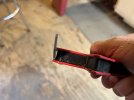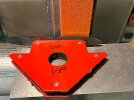- Joined
- Mar 6, 2022
- Messages
- 317
I can't stop watching Mike Snody video on how to make a knife. Something stuck in my head though, he shows these welded together steel blocks that he uses for doing the bevel grinding. Goes on to explain that it works also as a heat sink. But he does so, so quickly that I can't actually see what it is. Seems there is a flat piece of steel with another piece welded at some angle and perhaps a screw somewhere. I can't quite tell if he has one for each knife, or type of knife, or size of knife... or day of the week  because he shows "Here's how to do a big knife on a little block..."
because he shows "Here's how to do a big knife on a little block..." 


Others have grinding jigs that seem like they have lots of moving parts, or the front surface looks like a bad day at the Swiss cheese factory for all the holes.
I am of the opinion that simpler is always better. Especially when it comes to jigs. Can someone tell me the two important points of his grinding blocks.
1. The angle
2. Where to place the screw
And 2 are any of these other crazy looking things with either all sorts of angles and moving parts, or the million holes all over them any better?
And, before anyone suggests it, yes, I will try freehand.
Others have grinding jigs that seem like they have lots of moving parts, or the front surface looks like a bad day at the Swiss cheese factory for all the holes.
I am of the opinion that simpler is always better. Especially when it comes to jigs. Can someone tell me the two important points of his grinding blocks.
1. The angle
2. Where to place the screw
And 2 are any of these other crazy looking things with either all sorts of angles and moving parts, or the million holes all over them any better?
And, before anyone suggests it, yes, I will try freehand.


